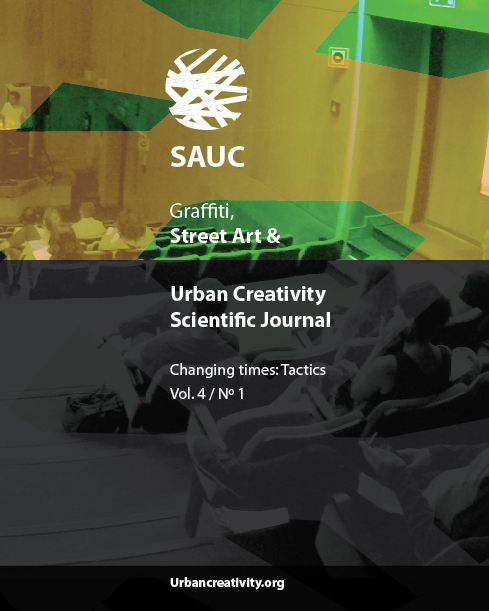With, On and Against Street Signs On Art Made out of Street Signs
DOI:
https://doi.org/10.25765/sauc.v4i1.124Keywords:
De Certeau, strategies, tactics, street signs, Dan Witz, Clet, Brad Dowley, DosJotasAbstract
In The Practice of Everyday Life (1980), Michel de Certeau suggests the idea of a city in which there are, on one side, strategies of information, surveillance, control and infrastructure design laid out by the system and, on the other one, tactics defining the how-to-do of the users with regards to that system, that is, the operations by which they adapt them to align their own interests and needs. The texts allows us to examine the interventions of urban artists as a tactic characterized, as defined by De Certeau, as the harnessing of the system's resources (making do). This is more specifically translated into adaptability, development on a space they do not own, identification and utilization of the occasion (time) and the inventiveness of diverting time and resources (shortcut and la
perruque).
In this work, we will take traffic signs of restriction and prohibition as one of the urban components that highlight the normativization of public spaces through the direct message of "NO" (not doing). Many artists have, in previous years, developed an interest in the artistic and symbolic possibilities of these signs and have developed works (tactics) as their response to them. Dan Witz (Chicago, 1957), Clet (Bretagne, 1966), Brad Dowey (Louisville, 1980) or DosJotas (Madrid, 1982) are good examples of this.
Downloads
Global Statistics ℹ️
|
195
Views
|
0
Downloads
|
|
195
Total
|
|
Downloads
Published
How to Cite
Issue
Section
License
Those authors who publish in this journal accept the following terms:
-
Authors retain copyright.
-
Authors transfer to the journal the right of first publication. The journal also owns the publishing rights.
-
All published contents are governed by an Attribution-NoDerivatives 4.0 International License.
Access the informative version and legal text of the license. By virtue of this, third parties are allowed to use what is published as long as they mention the authorship of the work and the first publication in this journal. If you transform the material, you may not distribute the modified work. -
Authors may make other independent and additional contractual arrangements for non-exclusive distribution of the version of the article published in this journal (e.g., inclusion in an institutional repository or publication in a book) as long as they clearly indicate that the work was first published in this journal.
- Authors are allowed and recommended to publish their work on the Internet (for example on institutional and personal websites), following the publication of, and referencing the journal, as this could lead to constructive exchanges and a more extensive and quick circulation of published works (see The Effect of Open Access).













